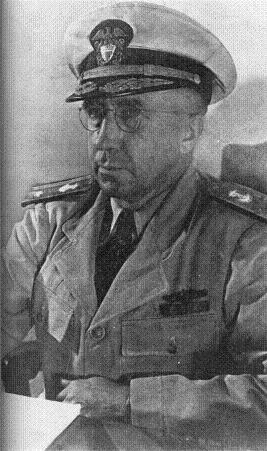![]() The Pacific War Online Encyclopedia
The Pacific War Online Encyclopedia
|
| Previous: Fickel, Jacob Earl | Table of Contents | Next: Fighters |

U.S. Navy. Via Blair (1975)
James Fife was an experienced submariner and former naval observer in London. He was assigned as chief of staff to Submarine Squadron 2 in the Philippines just before war broke out. Leaving Manila after the destruction of the naval base at Cavite, Fife subsequently left Corregidor with other submarine personnel on Seawolf, eventually making his way to Bandung. When Java fell, Fife escaped on a patrol aircraft, arriving at Fremantle in southwest Australia on 3 March 1942 to begin setting up a new submarine base.
At about this time, Fife and his squadron commander, John Wilkes,
prepared a report on submarine operations in southeast Asia for Admiral
King. This report was highly
insightful, identifying most of the weaknesses in the submarine force.
The Wilkes-Fife report noted that something was wrong with the Mark XIV
torpedo, suggesting that the
torpedoes were running too deep and that the magnetic exploders might
not be reliable -- both of which turned out to be the case. The
H.O.R. engines used on many boats were fingered as unreliable and in
need of replacement. Submarine silhouettes needed to be reduced by
cutting down their conning towers. Equipment
needed to be quieter. The submarines needed better distillers, radar, and air
conditioning. It had been discovered that the performance of
prospective submarine commanders was impossible to predict or test
except through actual command of a boat on war patrol, and the
recommendation was made that a skipper should be given two patrols to
prove himself or be relieved. Fife would later become notorious for his
ruthlessness in relieving skippers.
When Wilkes was rotated back to the U.S. in early 1942, he was replaced by Charles Lockwood. Fife and Lockwood got along well, and Fife was directed by Lockwood to get to the bottom of the torpedo problem. On 20 June 1942, at about the time that Fife was given command of Submarine Squadron 2, he conducted the first of a series of tests at his Albany headquarters that confirmed that the torpedoes were running too deep.
At the start of the war, submarine commanders were typically about
40 years old. Fife began assigning submarine commands to younger
officers, and by the end of the war the average submarine commander was
closer to 30 years old.
Transferred to eastern Australia in September 1942, Fife was later
send as
"special representative" of Arthur
Carpender, MacArthur's
naval commander, to MacArthur's forward headquarters at Port Moresby, effectively
giving up his squadron. His actual role was to protect the security of
Navy Ultra.
Fife relieved Christie as Commander, Task Force 42, Brisbane, in late December. Here he built up a magnificent submarine base, which included rest camps built around two resort hotels. Among the high-spirited and heavy-drinking submarine crews, he gained a reputation as nondrinker and a strict disciplinarian. Blair describes him as a "strange, solitary, almost lonely figure."
Believe that his commanders were too cautious, Fife began micromanaging his boats. Instead of letting the commanders use their own initiative in patrolling their areas, he moved his units like "checkers on a board' with the guidance of Ultra intelligence. In effect, he repeated the mistake of Doenitz in the Atlantic. The loss on 10 Jan 1943 of Argonaut, which really had no business making a regular war patrol, followed by the rapid loss of three fleet boats, prompted an informal investigation by McCann that exonerated Fife. Nevertheless, the controversy prompted Fife to offer his resignation to Carpender, which was refused. Fife had become a protege of MacArthur, and in turn he became a loyal member of "MacArthur's Navy."
At the beginning of 1944, Fife was rotated to Washington to become a war planner on King's staff. Fife remained in close touch with Lockwood and helped nudge along his proposals to the Washington brass.
In late 1944 Fife, now a rear admiral, returned to the Pacific to take command of all submarines in 7 Fleet. He was much less prone this time around to micromanage his commanders. Apparently he had learned a lesson. However, he went on patrol with Hardhead on 20 March 1945, a rather reckless stunt for a senior commander.
Postwar Fife served as an assistant to the General Board and Joint
Chiefs of Staff before becoming Commander, Submarines, Atlantic in
1948. He retired a year later, and died in 1975.
| 1897
|
Born in Nevada |
|
| 1918 |
Ensign |
Graduates from Naval Academy. Assigned to CL Tacoma |
| 1935 |
Commander, Nautilus |
|
| 1941-10
|
Commander
|
Chief of staff, Submarine
Squadron 2, Cavite |
| 1942-6 |
Commander, Submarine Squadron 2 |
|
| 1942-12-22
|
Commander, Task Force 42 |
|
| 1943-1-1
|
Captain |
|
| 1944-3-15 |
Staff, War Plans, U.S. Fleet |
|
| 1944-12-30
|
Rear
admiral |
Commander, Submarines, 7 Fleet |
| 1946 |
Assistant, General Board and
Joint Chiefs of Staff |
|
| 1947-4 |
Commander, Submarines, Atlantic |
|
| 1950-6 |
Assistant Chief of Naval Operations |
|
| 1953-3 |
Deputy commander, Mediterranean |
|
| 1955-8 |
Retires |
|
| 1975 |
Dies |
References
The Pacific War Online Encyclopedia © 2007, 2011 by Kent G. Budge. Index